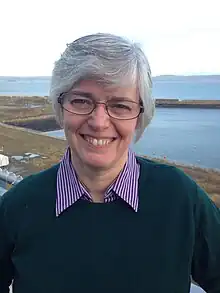Eleanor Campbell (scientist)
Eleanor Elizabeth Bryce Campbell FRSE FRS FRSC FInstP (born 13 April 1960) is a Scottish scientist who holds the Chair of Chemistry at the University of Edinburgh.[1][2]
Eleanor E.B. Campbell | |
|---|---|
 | |
| Born | 13 April 1960 |
| Nationality | Scottish |
| Alma mater | University of Edinburgh |
| Spouse(s) | Iain Campbell (1984–1991) Professor Mats Jonson (2003–) |
| Awards | FRSE (2004) Royal Swedish Academy of Science (foreign member) (2005) Fellow of the Royal Society of Chemistry (2008) Fellow of the Institute of Physics (2008) FRS (2010) |
| Scientific career | |
| Institutions | University of Edinburgh Freiburg University Max Born Institut Gothenburg University |
| Thesis | Electronic to rovibrational excitation in fast atom-molecule collisions (1985) |
| Doctoral advisor | Malcolm Fluendy |
Education
Campbell was born in 1960 in Rothesay on the Isle of Bute in Scotland to Isobel and William Cowan.[2] She was schooled at Rothesay Academy before going on to study for a BSc in Chemical Physics at the University of Edinburgh, passing with first class honours in 1980. She remained at the university for further 4 years studying for a PhD, which she gained in 1986,[3] on the topic of Electronic to rovibrational excitation in fast atom-molecule collisions.[4][5] She then went to the University of Freiburg having received a habilitation in experimental physics.[6]
Academic career
After her time as assistant professor at the University of Freiburg, Campbell became a departmental head at the Max-Born Institut in 1993. In 1998 she was made Chair of Atomic and Molecular Physics at Gothenburg University, Sweden before returning to the University of Edinburgh in to take up a post as Chair of Physical Chemistry in 2007 and then Chair of Chemistry 2013.[6]
Campbell was elected as a Foreign Member of the Royal Swedish Academy of Sciences (physics class) in 2005[7] and a Fellow of the Royal Society of Edinburgh in 2004.[8] In 2010 she was elected a Fellow of the Royal Society for her contribution to the understanding of relaxation channels and reorganisational dynamics of highly excited molecules and surfaces through experimental research.[9] She was made a Fellow of the Royal Society of Chemistry and a Fellow of the Institute of Physics in 2008.[2][10]
Current work
Campbell's group at the University of Edinburgh study the fundamental ionisation mechanisms and excited state dynamics of complex molecules in the gas phase using femtosecond laser spectroscopy. They also study carbon nanomaterials and develop microporous carbon-based materials for gas capture and storage.[11]
References
- "Professor Eleanor E. B. Campbell FRS | School of Chemistry". www.chem.ed.ac.uk. Retrieved 26 December 2017.
- Who's who. Oxford University Press. 2010. doi:10.1093/ww/9780199540884.013.251235.
- Bryce, Campbell, Eleanor Elizabeth (1986). "Electronic and vibrational excitation in atom / molecule collisions". hdl:1842/13295.
{{cite journal}}: Cite journal requires|journal=(help)CS1 maint: multiple names: authors list (link) - "Academy graduate joins Royal Society". The Buteman. 23 June 2010. Retrieved 4 October 2016.
- "Eleanor E.B. Campbell - Edinburgh Research Explorer". www.research.ed.ac.uk. Retrieved 26 December 2017.
- "Biography of Eleanor Campbell on University of Edinburgh website".
- "Kungliga Vetenskapsakademien - Contact Royal Swedish Academy of Sciences". www.kva.se. Retrieved 30 June 2016.
- "The Royal Society of Edinburgh | RSE Fellows". www.royalsoced.org.uk. Retrieved 30 June 2016.
- "Royal Society - Eleanor Campbell webpage".
- "Faraday Division Council Members". Royal Society of Chemistry. Retrieved 26 December 2017.
- "Eleanor Campbell Group | Eleanor Campbell site". www.ecampbell.chem.ed.ac.uk. Retrieved 30 June 2016.